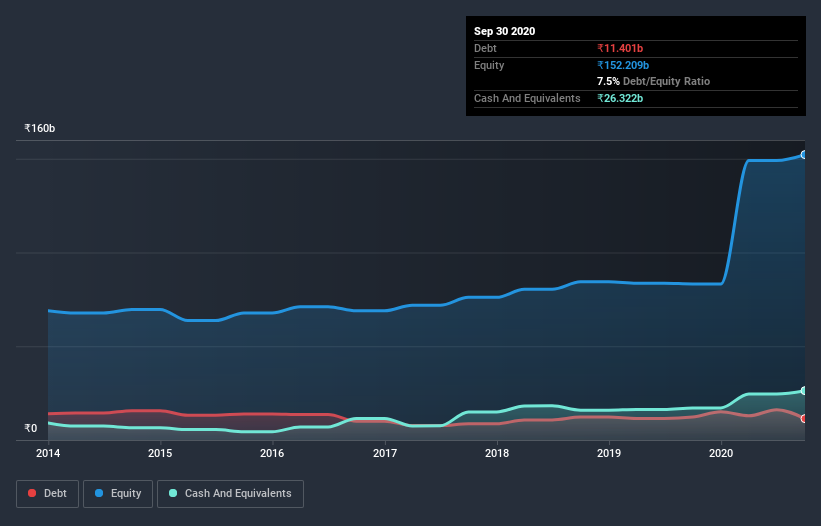Is Tata Consumer Products (NSE:TATACONSUM) A Risky Investment?

David Iben put it well when he said, 'Volatility is not a risk we care about. What we care about is avoiding the permanent loss of capital.' So it might be obvious that you need to consider debt, when you think about how risky any given stock is, because too much debt can sink a company. We note that Tata Consumer Products Limited (NSE:TATACONSUM) does have debt on its balance sheet. But should shareholders be worried about its use of debt?
When Is Debt Dangerous?
Debt is a tool to help businesses grow, but if a business is incapable of paying off its lenders, then it exists at their mercy. If things get really bad, the lenders can take control of the business. However, a more usual (but still expensive) situation is where a company must dilute shareholders at a cheap share price simply to get debt under control. Of course, the upside of debt is that it often represents cheap capital, especially when it replaces dilution in a company with the ability to reinvest at high rates of return. The first thing to do when considering how much debt a business uses is to look at its cash and debt together.
View our latest analysis for Tata Consumer Products
What Is Tata Consumer Products's Net Debt?
The image below, which you can click on for greater detail, shows that Tata Consumer Products had debt of ₹11.4b at the end of September 2020, a reduction from ₹12.2b over a year. However, its balance sheet shows it holds ₹26.3b in cash, so it actually has ₹14.9b net cash.

How Healthy Is Tata Consumer Products's Balance Sheet?
Zooming in on the latest balance sheet data, we can see that Tata Consumer Products had liabilities of ₹24.8b due within 12 months and liabilities of ₹17.0b due beyond that. Offsetting these obligations, it had cash of ₹26.3b as well as receivables valued at ₹9.00b due within 12 months. So it has liabilities totalling ₹6.51b more than its cash and near-term receivables, combined.
This state of affairs indicates that Tata Consumer Products's balance sheet looks quite solid, as its total liabilities are just about equal to its liquid assets. So while it's hard to imagine that the ₹530.8b company is struggling for cash, we still think it's worth monitoring its balance sheet. Despite its noteworthy liabilities, Tata Consumer Products boasts net cash, so it's fair to say it does not have a heavy debt load!
In addition to that, we're happy to report that Tata Consumer Products has boosted its EBIT by 44%, thus reducing the spectre of future debt repayments. The balance sheet is clearly the area to focus on when you are analysing debt. But it is future earnings, more than anything, that will determine Tata Consumer Products's ability to maintain a healthy balance sheet going forward. So if you're focused on the future you can check out this free report showing analyst profit forecasts.
Finally, a company can only pay off debt with cold hard cash, not accounting profits. While Tata Consumer Products has net cash on its balance sheet, it's still worth taking a look at its ability to convert earnings before interest and tax (EBIT) to free cash flow, to help us understand how quickly it is building (or eroding) that cash balance. During the last three years, Tata Consumer Products produced sturdy free cash flow equating to 58% of its EBIT, about what we'd expect. This cold hard cash means it can reduce its debt when it wants to.
Summing up
While it is always sensible to look at a company's total liabilities, it is very reassuring that Tata Consumer Products has ₹14.9b in net cash. And we liked the look of last year's 44% year-on-year EBIT growth. So we don't think Tata Consumer Products's use of debt is risky. When analysing debt levels, the balance sheet is the obvious place to start. But ultimately, every company can contain risks that exist outside of the balance sheet. For example, we've discovered 1 warning sign for Tata Consumer Products that you should be aware of before investing here.
If, after all that, you're more interested in a fast growing company with a rock-solid balance sheet, then check out our list of net cash growth stocks without delay.
If you decide to trade Tata Consumer Products, use the lowest-cost* platform that is rated #1 Overall by Barron’s, Interactive Brokers. Trade stocks, options, futures, forex, bonds and funds on 135 markets, all from a single integrated account. Promoted
Valuation is complex, but we're here to simplify it.
Discover if Tata Consumer Products might be undervalued or overvalued with our detailed analysis, featuring fair value estimates, potential risks, dividends, insider trades, and its financial condition.
Access Free AnalysisThis article by Simply Wall St is general in nature. It does not constitute a recommendation to buy or sell any stock, and does not take account of your objectives, or your financial situation. We aim to bring you long-term focused analysis driven by fundamental data. Note that our analysis may not factor in the latest price-sensitive company announcements or qualitative material. Simply Wall St has no position in any stocks mentioned.
*Interactive Brokers Rated Lowest Cost Broker by StockBrokers.com Annual Online Review 2020
Have feedback on this article? Concerned about the content? Get in touch with us directly. Alternatively, email editorial-team@simplywallst.com.
About NSEI:TATACONSUM
Tata Consumer Products
Produces, distributes, and trades in food products in India, the United States, the United Kingdom, and internationally.
Flawless balance sheet established dividend payer.


